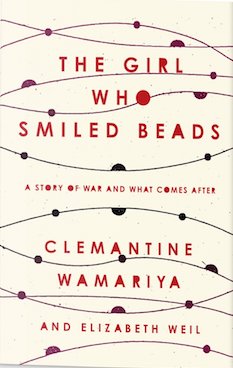Review: The Girl Who Smiled Beads: A Story of War and What Comes After
by Clemantine Wamariya and Elizabeth Weil (Crown, 2018)
This debut memoir (co-written with journalist Elizabeth Weil) reflects a heroic journey from Rwanda to America. Author Clemantine Wamariya was 5 years old in 1994, when violence devastated her home in Kigali, Rwanda. She and her sister Claire, 14, endure a quest for safety that meanders through Burundi, Zaire (Congo), Tanzania, Malawi, Mozambique, South Africa, and Zambia. A map illustrates the sisters’ route. The book zig-zags back and forth in time, with lyrical descriptions of Clemantine’s interior journey as well as the physical landscapes. All the while, they’re grappling with loss of both home and family, uncertain whether their siblings or parents survived.
I was immediately drawn into this book. I once traveled through the region—as a self-styled refugee from America—seeking my own place in a complicated world. Since those years, I often wonder what happened to the families who befriended and sometimes sheltered my little tribe of grungy Mzungu backpackers. In most ways Clemantine’s story and mine are opposites.
“It’s strange how you go from being a person who is away from home to a person with no home at all. The place that is supposed to want you has pushed you out. No other place takes you in. You are unwanted, by everyone. You are a refugee.”
On occasion, the sisters find temporary safety at United Nations-built refugee camps. Yet, camp residents compete for shelter, water, food, and human dignity. Myriad health challenges include nits and foot-attacking parasites. Sensory realities of life in a refugee camp and life on the run are rendered with lyrical prose. While Clare starts a business buying and selling goats and other supplies, Clemantine finds solace while doing chores, from her memories, and from stories told by kind elders.
The title The Girl Who Smiled Beads comes from a Rwandan folk tale. I will not spoil the secret. You must read this book to learn what it means to be a child of war, a child who survives to share her own stories.
Eventually, the sisters find asylum in America, with new challenges. By this time Claire is unhappily married to once-beloved Rob, with small children of her own. Clemantine tumbles head-on into life as a teen in America, sheltered near Chicago with a generous foster family.
“I didn’t want to be asked about death. I did not want to be a tool or a case study. I did not want to be that Rwandan Girl. Yet inevitably I was a curiosity, an emissary from suffering’s edge.”
Clemantine has crafted a riveting story of survival and resilience. In some ways, her quest for belonging is similar to what every young person grapples with, albeit on a different scale, with unique circumstances.
Resonant with gritty endurance like Cheryl Strayed’s Wild, this memoir is also a close-up portrait of war’s effect on childhood like Ishmael Beah’s A Long Way Gone. As a family migration story, it will appeal to fans of Reyna Grande’s The Distance Between Us or Syrian Yusra Mardini’s Butterfly. Highly recommended for reading groups, for YA classrooms, and for anyone who wants to learn more about the refugee situation in Central and East Africa.
Like Elie Wiesel and Malala Yousafzai, Clemantine Wamariya is using her platform as a survivor to advocate for peace and forgiveness and tolerance. She is a voice for all of humanity, in this era when more than 60 million people—many of them children— are surviving in exile.
